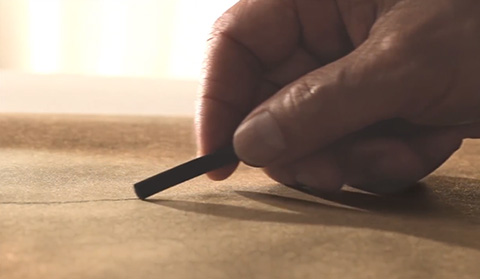Through line, Gustav Klimt sought to convey the essence of the human form and the nature of human existence. Learn about his artistic process in this video.

The Ruins of the Imperial Palaces in Rome, about 1831, Carl Rottmann, graphite and watercolor with touches of white gouache. The J. Paul Getty Museum
Poppy, about 1800–1803, Philipp Otto Runge, cutout silhouette on white paper affixed to blue-gray paper. The J. Paul Getty Museum, Purchased with funds provided by the Disegno Group and Alex Bouzari
A Walk at Dusk, about 1830–35, Caspar David Friedrich, oil on canvas. The J. Paul Getty Museum
A Swan among Reeds by Moonlight, September 18, 1852, Carl Gustav Carus, charcoal with white chalk heightening on brown paper. The J. Paul Getty Museum
Girl Shading Her Eyes, about 1908, František Kupka, pastel. The J. Paul Getty Museum, Gift of Richard A. Simms in Memory of James N. Wood (1941-2010), President and Chief Executive Officer of the J. Paul Getty Trust 2007-2010. © 2014 Artists Rights Society (ARS), New York / ADAGP, Paris
Two Studies of a Seated Nude with Long Hair, about 1901–2, Gustav Klimt, black chalk and red pencil. The J. Paul Getty Museum
Queen of the Night, about 1864–67, Moritz von Schwind, watercolor over graphite. The J. Paul Getty Museum
Fridolin Assists with the Holy Mass, 1833, Peter Fendi, gouache, watercolor, and graphite. The J. Paul Getty Museum
View of the Residence of Archduke Johann in Gastein Hot Springs, about 1829–32, Thomas Ender, watercolor over graphite. The J. Paul Getty Museum
Spring Has Arrived, 1870, Ludwig Richter, watercolor, graphite, gouache, and touches of red chalk. The J. Paul Getty Museum
February 10–May 17, 2015Getty Center
Between 1800 and 1900 the Germanic world underwent profound intellectual, social, economic, and political changes. The Industrial Revolution, the formal unification of Germany into a nation state, and the invention of psychoanalysis shaped modern life and its representations in art.
Philosopher Georg Wilhelm Hegel professed that art was a fundamental mode of consciousness whereby humans could reach a profound understanding of themselves and the world. Art reflected the spirit of the age (“Zeitgeist” in German) in which it was created, and this influential notion held sway throughout the 19th century. Drawing proved to be an essential expression of the period.
This two-gallery exhibition, which includes the works of Caspar David Friedrich, Philipp Otto Runge, and Gustav Klimt, brings together paintings, drawings, and prints from the Museum's collection, the Getty Research Institute, and distinguished local private collections.
See more

Through line, Gustav Klimt sought to convey the essence of the human form and the nature of human existence. Learn about his artistic process in this video.
Free GettyGuide® Multimedia Player
Learn more about individual works in Zeitgeist chosen from the Museum's collection. Pick up a multimedia player free of charge in the Museum Entrance Hall.
Download the illustrated exhibition checklist PDF (7 PP, 1.3 MB).